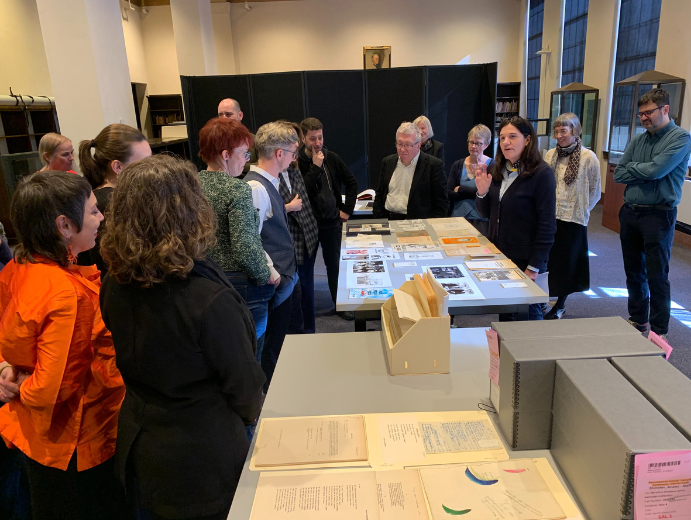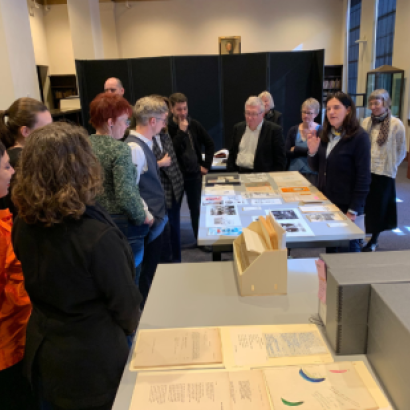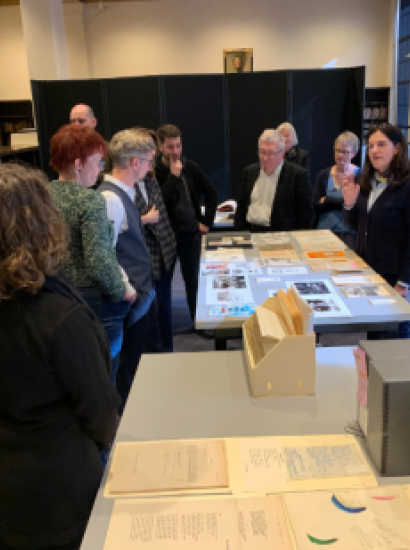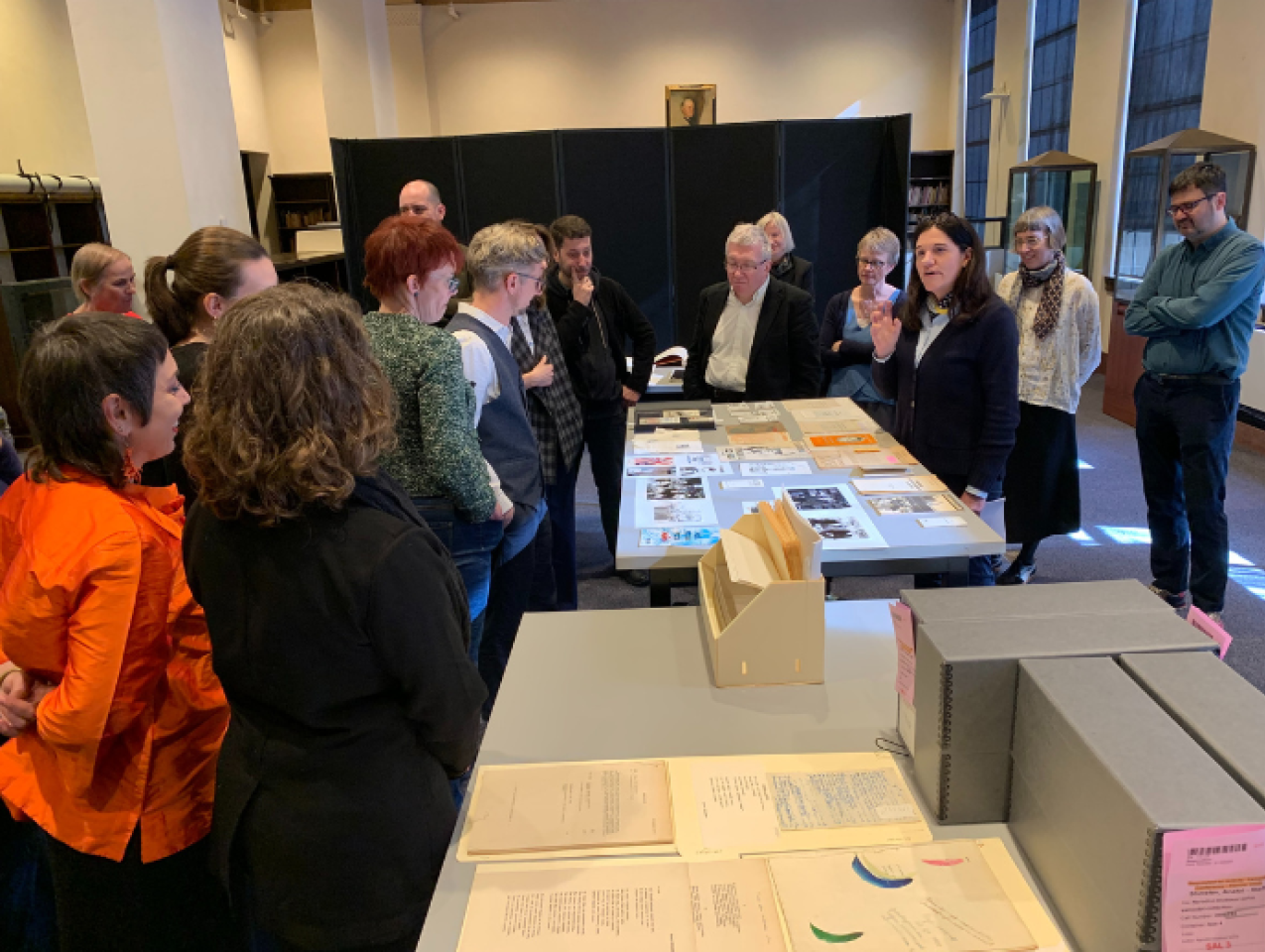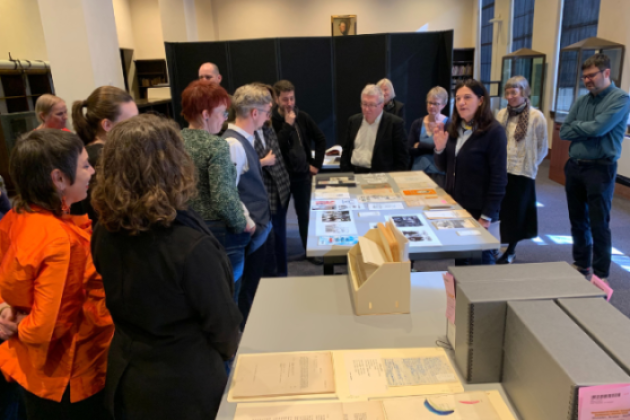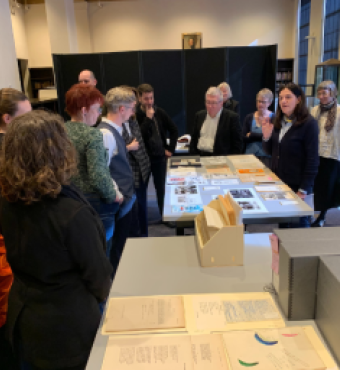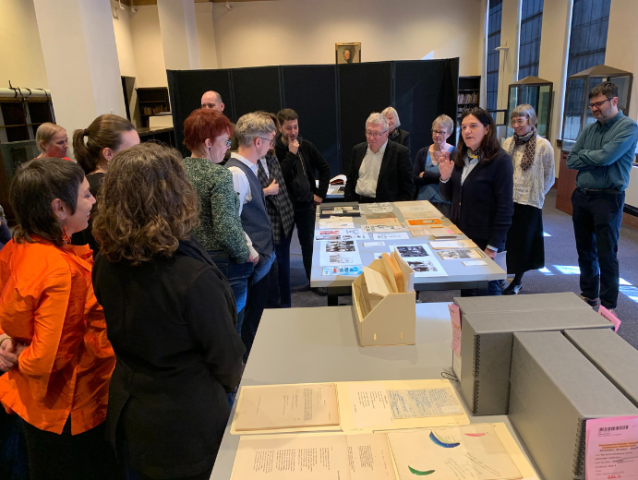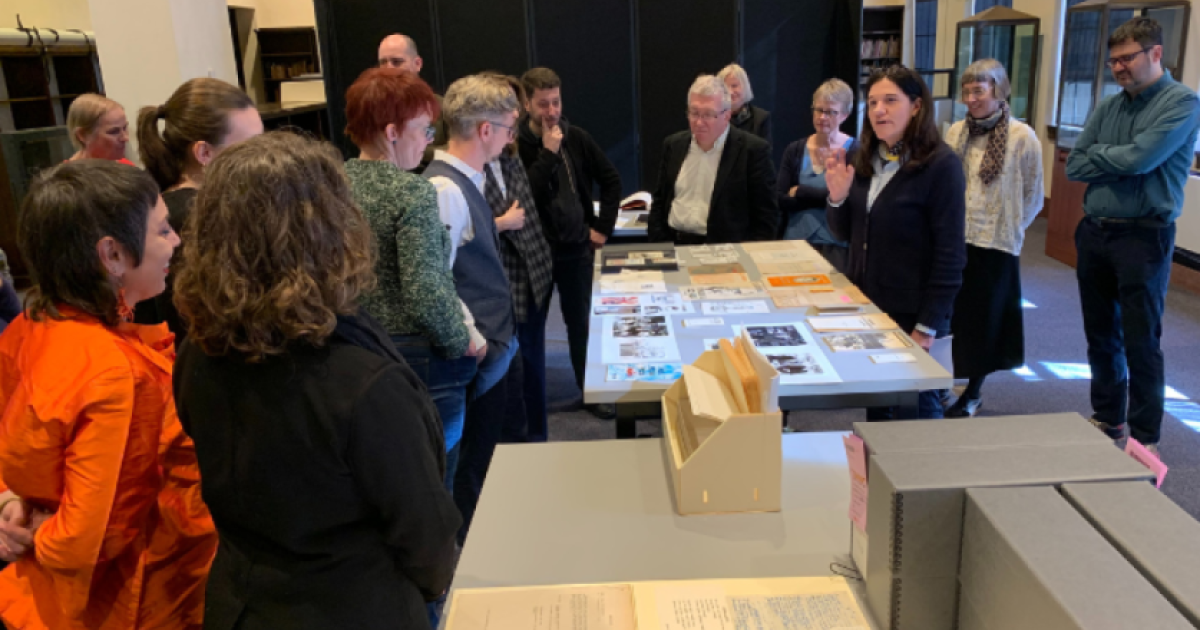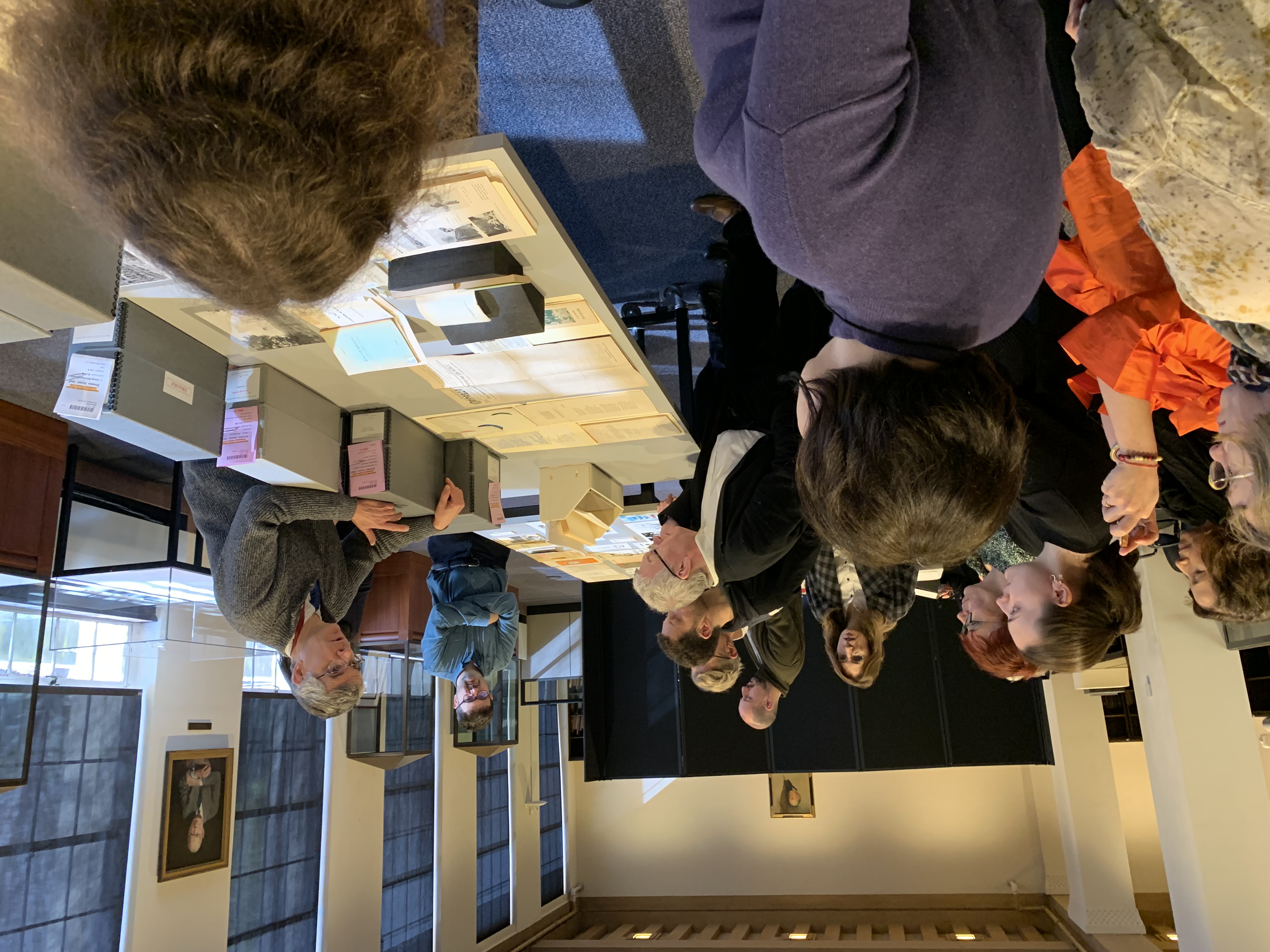
The terms Samizdat and Tamizdat are familiar to broad segments of people in the former Union of Soviet Socialist Republics (USSR) and Eastern Europe, but not so much in countries with a free press. The root common to both – izdat – refers to “publishing”, and Sam means “Self”, while Tam means “There”, referring to underground and illegal publishing within the Soviet Bloc in the first case, and literature published abroad and smuggled into the bloc in the second case. This was the subject of Transnational Paths and Networks, sponsored by Stanford CREEES, CESTA, the Department of Slavic Languages and Literatures, and the Division of Literatures, Cultures, and Languages, held at Stanford University on March 12-13, 2025. Part of the conference program centered around a temporary yet extraordinary exhibit of relevant archival materials collected by the Hoover Institution Library & Archives and Stanford University Libraries’ Special Collections.
The exhibit was opened by guest Barbara Krupa of Stanford University Libraries, who exhibited several rare items, both Samizdat and Tamizdat, primarily surreptitiously published in Poland or aimed at Polish audiences in the 1970s and 1980s. Dr. Krupa is herself a student of this subject and brought to light understudied sources that allowed for a deeper understanding of these phenomena.
The conference participants’ attention was immediately drawn to the book by Maryna Miklaszewska, writing under the pseudonym Miłosz Kowalski, Mikołajek w szkole PRL (Nick in the School of the Polish People’s Republic), published in London by Anex in 1987. Inspired by the French Le Petit Nicolas by René Goscinny, the book maintains the look of a children’s story but resonates more with adult readers due to its dark, absurd portrayal of life during that era. Notably, the illustrations were created by the author’s 10-year-old son.
Polish literary Samizdat was represented by an issue of “Puls” (Puls), an irregular literary quarterly published in Łódź from 1977 to 1981, along with a few items from the post-Perestroika newspaper collection, including the self-published Domashnii Zhurnal from Leningrad, as well as a small, humorous, artistic book from Odessa, Diukastyi, portastyi odesskii passport.

Additionally, the Metropol’ Almanac was presented, a collection of uncensored works by renowned writers, including Andrei Voznesensky, whose papers are housed in the Special Collections at Stanford University Libraries. This almanac was self-published in Moscow in December 1978, smuggled to the U.S., and later published by Ardis.
The Taube Family Curator for European Collections at the Hoover Institution Library & Archives, Katharina Friedla, presented an amazing display of materials from various Eastern European collections and focused the participants’ attention on the holdings of two spectacular collections, the papers of Irena Lasota and Joanna Szczęsna, underscoring the popularity of such publications among dissident intellectuals in all countries of the Soviet Bloc.
Both collections showcase the activism of women in the production and distribution of independent publications. Irena Lasota, a Polish dissident forced to leave communist Poland in the late 1960s and settled in the United States, collected and distributed independent publications from Central Eastern Europe and actively supported the anti-communist opposition activities in Poland. Joanna Szczęsna, based in Warsaw, has been a democratic opposition activist since 1970 and has published and edited a lot of independent publications in communist Poland.
Also notable were leaflets distributed by balloon: The Free Europe Committee, a precursor to Radio Free Europe, engaged in numerous balloon drops in the 1950s, in the course of which leaflets were placed in boxes attached to balloons: dry ice on the side of the box slowly evaporated, eventually causing the box to flip and dump its contents over a particular target area. Of course, everything depended on the winds. It was rare for a balloon to actually deliver its payload to a major metropolitan area, but the idea seemed promising at the start. Later, radio became the leading medium for the spread of ideas across the Iron Curtain, and the balloon operations were discontinued.
Anatol Shmelev, Robert Conquest Curator for Russia, Ukraine and Eurasia, displayed an array of items ranging from actual Samizdat smuggled out of the USSR (mainly held in the NTS Samizdat collection) to the products of specialized Tamizdat publishers (particularly NTS, Overseas Publications Interchange, YMCA and others), printed specially for smuggling or clandestine transportation into the USSR. One of the items displayed was a pamphlet about Gerald Brooke, a British teacher caught at the Soviet border with a suitcase full of NTS publications, jailed by the Soviets for four years, and freed in exchange for Soviet spies Morris and Lona Cohen in 1969. Another was a rare Ukrainian edition of Andrei Amalrik’s Will the Soviet Union Survive Until 1984?
The most popular items were a copy of Alexander Solzhenitsyn’s Gulag Archipelago, requiring a powerful magnifying glass to read, and a newspaper camouflaged to look like a regular issue of the leading Soviet newspaper Pravda, which, when opened, revealed articles by émigré anti-Soviet activists: these types of publications were smuggled into the USSR by sailors and tourists, who received them from émigrés meeting Soviet ships in port or attaching themselves to tourist groups.
Though the conference participants were experienced in research and familiar with the literature and primary sources, they lingered to ask questions and express their astonishment at the items presented, which they had never seen or heard of previously. The participants were grateful for how carefully the materials were housed and preserved, ensuring the long-term safety of Hoover’s collections.
Such fruitful exchanges help the Library & Archives’ curators focus their collecting to better assist researchers and to help advance scholarship through new avenues of inquiry.
The exhibition was organized in collaboration with Dr. Ilaria Sicari, a post-doctoral Marie Skłodowska-Curie fellow of the University Ca’ Foscari of Venice and visiting scholar at Stanford CREEES and CESTA, where she is carrying on a research project on the transnational routes and networks of Tamizdat. A specialist on Soviet and Eastern European unofficial (uncensored) literature, Dr. Sicari collaborated in the selection of Samizdat and Tamizdat editions exhibited at the event. At the moment, she is working with Anatol Shmelev, Katharina Friedla, and Barbara Krupa on the realization of a Spotlight digital exhibit entirely devoted to a selection of Tamizdat stored at Stanford University's Green Library and the Hoover Institution Library & Archives: Tamizdat@Stanford.




